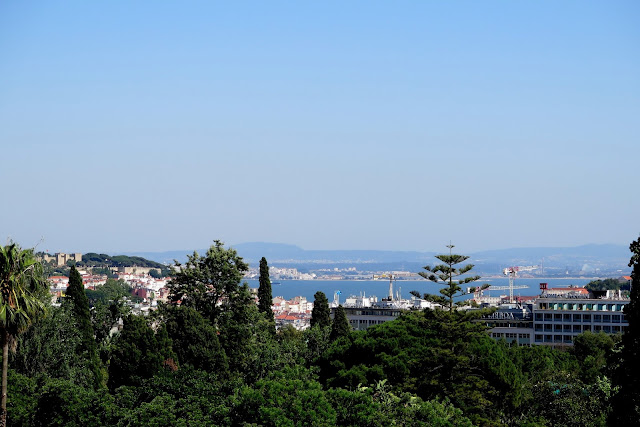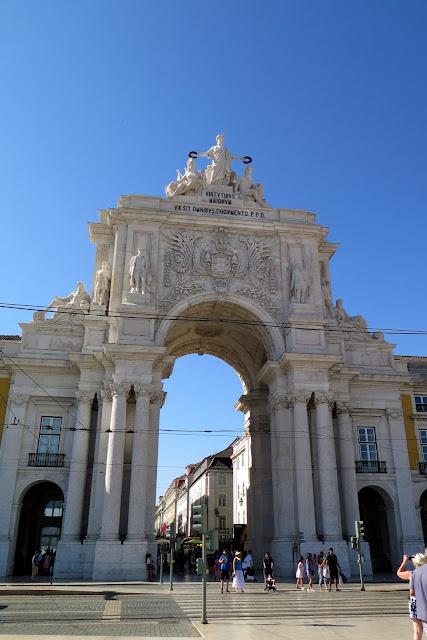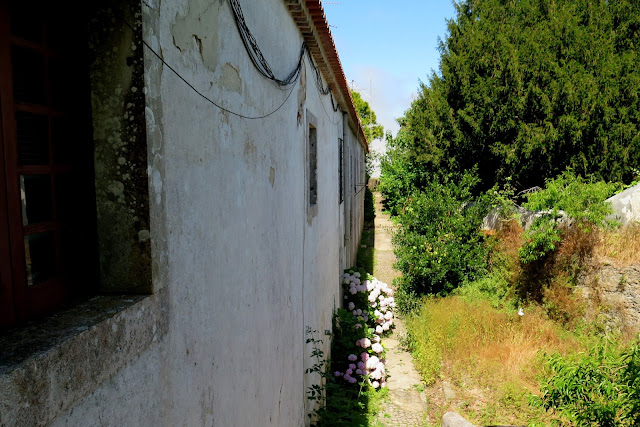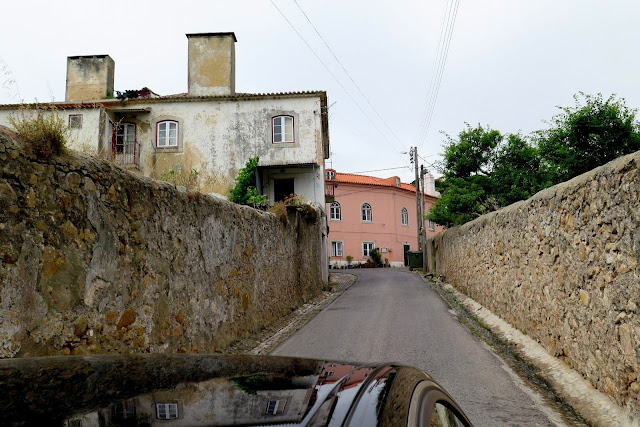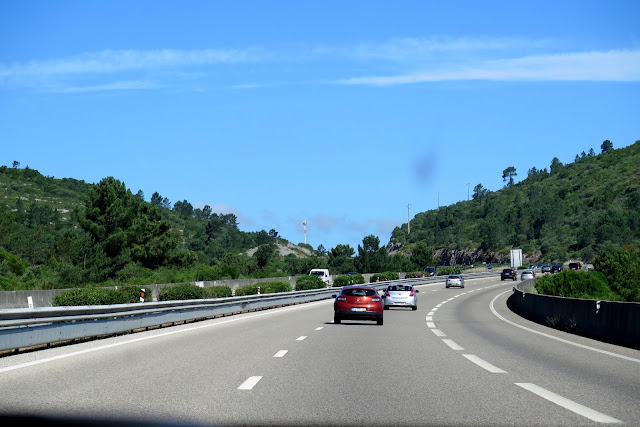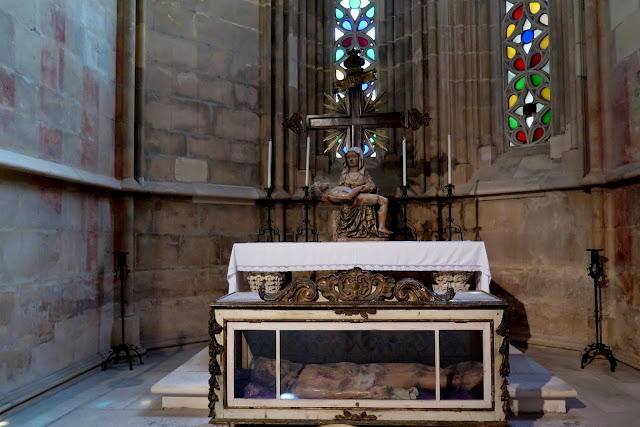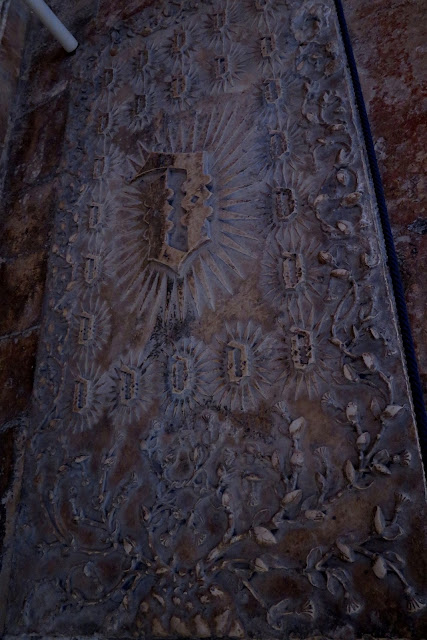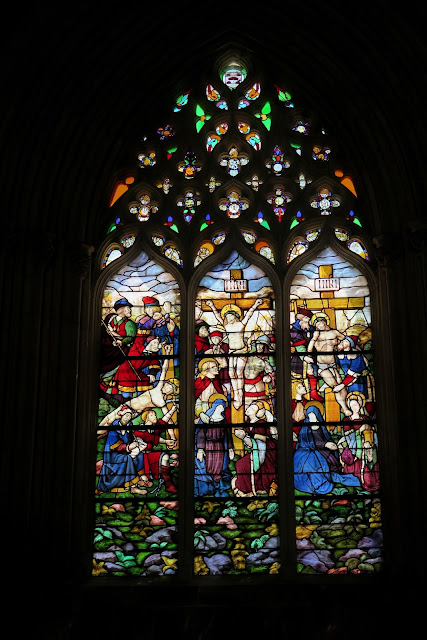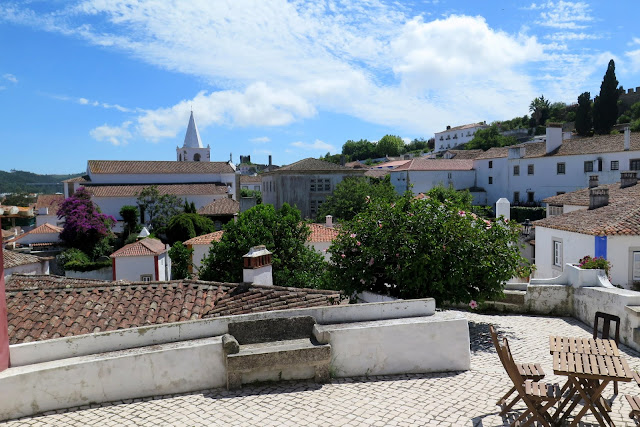Day 7
Portugal !!!!!
This is our last port.
Today we tour the capital...
Stay one more night on the ship...
And tomorrow onwards we tour other parts of the country .
Tul- tuk
Downtown Lisbon .
All from the comforts of our coach .
A mix of the old and new .
This was just before the Euro 2016...They were putting up a big screen here .
Ancient foundation stones .
The 25 de Abril Bridge is a suspension bridge connecting the city of Lisbon, capital of Portugal, ... Because it is a suspension bridge and has similar coloring, it is often compared to the Golden Gate Bridge in San Francisco, US
The city is quiet and quite nice .
Our first stop was here .,
The Jerónimos Monastery or Hieronymites Monastery is a former monastery of the Order of Saint Jerome near the Tagus river in the parish of Belém, in the Lisbon
The construction of the monastery and church began on 6 January 1501, and was completed 100 years later.
The monastery is one of the most prominent examples of the Portuguese Late Gothic Manueline style of architecture in Lisbon. It was classified a UNESCO World Heritage Site, along with the nearby Tower of Belém, in 1983.
This shrine-like portal is large, 32 metres (105 ft) high and 12 metres (39 ft) wide, extending two stories. Its ornate features includes an abundance of gables and pinnacles, with many carved figures standing under a baldachin in carved niches, around a statue of Henry the Navigator, standing on a pedestal between the two doors.
The tympanum, above the double door, displays, in half-relief, two scenes from the life of Saint Jerome: on the left, the removal of the thorn from the lion's paw and, on the right, the saint's experience in the desert. In the spandrel between these scenes is the coat-of-arms of king Manuel I, while the archivolt and tympanum are covered in Manueline symbols and elements. The Madonna (Santa Maria de Belém) is on a pedestal on top of the archivolt, surmounted by the archangel Michael, while above the portal there is a cross of the Order of Christ. The portal is harmoniously flanked on each side by a large window with richly decorated mouldings.
We enter through the south portal.
One of many chapels .
Six 25-metre-high, slender, articulated, octagonal columns with refined grotesque or floral elements typical of the Renaissance style. The construction of this late-Gothic hall is aesthetically and architecturally a masterwork: it augments the spatial effect of this vast building. The northern column closest to the transept there is a medallion that may have been intentionally included as a portrait of Boitac or Juan de Castilho.
Along one side....
More on this tomb later...
Huge stained glass .
That's also a tomb .
More chapels .
Another tomb resting on the elephant figurines .
The main altar .
This is a big place .
The elephants symbolize -travel to India .
The Portuguese sailors were some of the worlds best .
This is the tomb of Vasco da Gama.
Vasco da Gama, 1st Count of Vidigueira, was a Portuguese explorer and the first European to reach India by sea. His initial voyage to India (1497–1499) was the first to link Europe and Asia by an ocean route, connecting the Atlantic and the Indian oceans and, in this way, the West and the Orient.
Da Gama's discovery of the sea route to India was significant and opened the way for an age of global imperialism and for the Portuguese to establish a long-lasting colonial empire in Asia. Traveling the ocean route allowed the Portuguese to avoid sailing across the highly disputed Mediterranean and traversing the dangerous Arabian Peninsula. The sum of the distances covered in the outward and return voyages made this expedition the longest ocean voyage ever made until then, far longer than a full voyage around the world by way of the Equator
His final voyage .
There is more to see but time constraints limit it .
Hard to get an empty South portal .
A short drive further...
Past more medieval buildings .
That building is a must see...
The army museum...
Till we reach here...
The surrounding grounds .
The Christ the King statue is a Catholic monument and shrine dedicated to the Sacred Heart of Jesus Christ overlooking the city of Lisbon in the central part of Portugal. It was inspired by the Christ the Redeemer statue in Rio de Janeiro (Brazil), after the Cardinal Patriarch of Lisbon visited that monument. The project was inaugurated on 17 May 1959, while Portugal was ruled by the authoritarian President of the Council of Ministers António de Oliveira Salazar who gave his final permission for the project. The giant statue in cement was erected to express gratitude because the Portuguese were spared the effects of World War II.
That away...
The bridge again...with the Christ statue to its right
locals... :-P
Here we are...
Belém Tower or the Tower of St Vincent[1] is a fortified tower located in the civil parish of Santa Maria de Belém in the municipality of Lisbon, Portugal. It is a UNESCO World Heritage Site because of the significant role it played in the Portuguese maritime discoveries of the era of the Age of Discoveries
Oooooooooo
The tower was built in the early 16th century and is a prominent example of the Portuguese Manueline style,[4] but it also incorporates hints of other architectural styles.[5] The structure was built from lioz limestone and is composed of a bastion and a 30-metre (98.4 ft),[1] four-storey tower. It has incorrectly been stated that the tower was built in the middle of the Tagus and now sits near the shore because the river was redirected after the 1755 Lisbon earthquake. In fact, the tower was built on a small island in the Tagus River near the Lisbon shore
The Belém Tower is situated on the northern bank of the Tagus River
After a good look we leave.
Past more locals
And tuk-tuks.
And we come here...
The Discoveries Monument, built on the north bank of the Tagus River in 1960 to commemorate the 500th anniversary of the death of Prince Henry the Navigator.
It represents a three-sailed ship ready to depart, with sculptures of important historical figures such as King Manuel I carrying an armillary sphere, poet Camões holding verses from The Lusiads, Vasco da Gama, Magellan, Cabral, and several other notable Portuguese explorers, crusaders, monks, cartographers, and cosmographers, following Prince Henry the Navigator at the prow holding a small vessel. The only female is queen Felipa of Lancaster, mother of Henry the navigator, the brain of the discoveries.
Its quite big .
Right on the banks of the river .
The surrounding monuments .
Bridge ,river and statue...
And old Citroen truck .
Back on the coach...
We head here...
A giant Portugal flag.
And the fountain...
The view from the fountain.
The Eduardo VII Park is a public park in Lisbon, Portugal.[1] The park occupies an area of 26 hectares to the north of the Avenida da Liberdade and the Marquess of Pombal Square, in the centre of the city.
Its name pays homage to Edward VII of the United Kingdom who visited Portugal in 1902, to strengthen the relations between the two countries.
Zoom.
The same statue as above .
Now we're headed...downtown
Sights .
We drive to the city...
We are headed to the old quarter .
From there we will start walking .
More sights .
Plazas everywhere .
See the big screen bottom left. For the Euro finals .
From this point we start walking .
We are headed to Alfama .
The Alfama is the oldest district of Lisbon, spreading on the slope between the São Jorge Castle and the Tejo river. Its name comes from the Arabic Al-hamma, meaning "hot fountains" or "baths" (the name "Alfama" could also be derived from the Arabic word Alfamm, meaning the "mouth" in Arabic.
Named after the general.
During the times of Moorish domination, Alfama constituted the whole of the city, which later spread to the West (Baixa neighbourhood). Alfama became inhabited by the fishermen and the poor, and its condition as the neighbourhood of the poor continues to this day. The great 1755 Lisbon earthquake did not destroy the Alfama, which has remained a picturesque labyrinth of narrow streets and small squares
Nice huh .
Huge walls of the castle .
Makes the buildings look small .
Quaint cafes everywhere .
Cobblestones...
More cafes...
And more cobblestones .
Iberian decor .
Tuk-Tuks .
After a long day...we head back to the ship.
And have dinner in one of the many restaurants .
Tonight is the last night on board.
Tomorrow we tour Portugal proper .
Day 8
We're met by our driver.
As we head out of the city we pass these huge aqueducts .
After the cruise we have a few more days to explore the country .
For the first stop we are headed to the highlands .
Foggy and cold.
Even though this is summer .
A nice quiet village .
As we make our way uphill...
We pass natural springs where people collect the fresh mineral water .
Small cafes along the way .
Further up...
More fog...
We finally reach the top .
This huge castle is our destination .
A bit later the fog would clear .
The Pena Palace is a Romanticist castle in São Pedro de Penaferrim, in the municipality of Sintra, Portugal. The castle stands on the top of a hill in the Sintra Mountains above the town of Sintra, and on a clear day it can be easily seen from Lisbon and much of its metropolitan area. It is a national monument and constitutes one of the major expressions of 19th-century Romanticism in the world. The palace is a UNESCO World Heritage Site and one of the Seven Wonders of Portugal
A very unique architecture .
And colourful .
The Pena Palace has a profusion of styles much in accordance with the exotic taste of the Romanticism. The intentional mixture of eclectic styles includes the Neo-Gothic, Neo-Manueline, Neo-Islamic and Neo-Renaissance. References to other prominent Portuguese buildings such as the Belém Tower are also present.
The castle's history started in the Middle Ages when a chapel dedicated to Our Lady of Pena was built on the top of the hill above Sintra. According to tradition, construction occurred after an apparition of the Virgin Mary.
See him.?
On the ramparts .
A fine line between genius and........
The Triton .
What a looker .
He guards the entrance .
Still quite foggy .
So one can enjoy the view of milk?
There you go
We take a walk outside the castle first .
Small narrow paths...
Runs all around the exterior .
Cupolas along the way .
Finally back to the front .
Beauty and the beast .
Time for the interior .
A nice courtyard .
Majestic .
Remains of the Hieronymite convent .
The royal family used this as their summer palace .
Hence the grandeur .
You are being watched .
Tre cool cabinet .
Even cooler .Jade inlays.
Amazing work .
To be expected...
Opulence everywhere .
We continue past more rooms...
Till we head down...
To this room...
The noble room .
Nice ...looks comfy .
A collection of stained glass.
Actually very cool .
From the big to the small .
The good old days of random shooting of animals....
Trophy's .
No wenches around...sigh
As we reach the ramparts the fog starts to clear .
and the views are amazing .
What a place .
Now we can appreciate the varied colours .
Its time to leave...
But we can't take our eyes off this place.
Truly amazing .
Where to now...
We head to the city center .
See the walls up on the hill
Remains of a Moorish castle .
The Castle of the Moors (Portuguese: Castelo dos Mouros) is a hilltop medieval castle located in the central Portuguese civil parish of Santa Maria e São Miguel, in the municipality of Sintra, about 25km northwest of Lisbon. Built by the Moors in the 8th and 9th centuries, it was an important strategic point during the Reconquista, and was taken by Christian forces after the fall of Lisbon in 1147
The castle was constructed during the 8th and 9th centuries, during the period of Muslim Iberia, as the central place in a territory that was primarily agricultural, and which was necessary to protect its population
Our main focus was here .
The surrounding town. .
The Palace of Sintra (Portuguese: Palácio Nacional de Sintra), also called Town Palace (Palácio da Vila Vila=Town) is located in the town of Sintra, in the Lisbon District of Portugal. It is a present-day historic house museum.
It is the best-preserved medieval royal residence in Portugal, being inhabited more or less continuously from at least the early 15th century to the late 19th century.
Nice town and castle in the background .
More sights of the town ..
Someones profile pic :-P
Time to check out this palace .
The town around it is so quaint .
Nice huh .
We decided to just walk outside...
As we were hungry .
That is the kitchen chimney .
The rear is a bit rundown....peasants nowadays...sheesh .
Prior to this Spain was my favourite European country .
Now its Portugal .
As we continue our drive...
We pass many villas and mansions .
A quick stop here for the view.
That view .
Of the gardens and the countryside .
This place is quite interesting .
The Seteais Palace (Portuguese: Palácio de Seteais) is a neoclassical palace located in Sintra, Portugal. It is now a luxury hotel, restaurant and a tourist attraction .
The Seteais Palace was built between 1783 and 1787 for the Dutch consul Daniel Gildemeester, on lands granted by the Marquis of Pombal. The consul chose to build his house on the border of an elevation, from which the vast landscape around the Sintra hills could be admired. The palace was surrounded with a large garden with fruit trees.
Time to leave.
As we make our way down... we see this...
The grey stone column with its barley-sugar twist rose from the centre of Dr Gregorio d'Almeida Square. "The pillory of Sintra town in the 16th century," Here they would tie up criminals for the population to throw things at them: tomatoes and rotten vegetables usually, but stones for a serious crime .
Very narrow streets .
We reach our next stop...
Lots of bikers as the winding roads were fun.
A short walk...
The Cabo da Roca Lighthouse is a beacon/lighthouse located 165 metres (541 ft) above the Atlantic Ocean, on Portugal's (and continental Europe's) most westerly extent (Cabo da Roca).
This is the western most point on mainland Europe .
The Atlantic .
You are not supposed to go beyond the wall.....dumbasses.
The Continental marker
After getting our fill we head down....
Past isolated beaches...
Beautiful towns...
Down by the sea there is no fog .
We reach my favourite part of Portugal .
Cascais .
Cascais is a coastal town and a municipality in Portugal, 30 kilometres (19 miles) west of Lisbon. It is a cosmopolitan suburb of the Portuguese capital and one of the richest municipalities in Portugal.
My model...models.
It is located on the Estoril Coast (also known as the Portuguese Riviera), in the Greater Lisbon subregion .
Lunch right by the beach .
I could live here .
Asia is rush,rush,rush......
Here its so nice .
look at that .
We take a last look...
Leave this paradise...
And head back to Lisbon .
passing this.....
The Sao Juliao da Barra is a massive 16th century coastal defence complex situated on the headland between the Praia de Carcavelos and the Praia da Torre. The Juliao da Barra fort is the largest sea defence structure in Portugal and was primary constructed to guard the Tagus River and Lisbon from sea bound invasion. The fort also marks the mouth of the Rio Tejo.
Back in Lisbon ,eat and zzzzzzzzzzzzzzzz
Day 9
The next day we continue our tour.
A different part of Portugal.
First we visit Fatima.
The civil parish has been permanently associated with the Marian apparitions that were witnessed by three shepherd children at the Cova da Iria in 1917. The Catholic Church later recognized these events as "worthy of belief." A small chapel was built here in honor of Our Lady of Fátima beginning in 1918, and a statue of her installed. It has crowned by the Vatican. The chapel and statue have since been enclosed within a large shrine and basilicas. Associated facilities, including a hotel and medical facility, have also been built over the decades at this site. Each year thousands of pilgrims visit the Sanctuary of Fátima.
Huge grounds.
The reported apparitions at Fátima were officially declared worthy of belief by the Catholic Church, which commemorates the event on the same date. The published memoirs of Lúcia Santos' in the 1930s revealed two secrets that she claimed came from the Virgin while the third secret was revealed by the Catholic Church in 1960. The controversial events at Fátima gained fame due partly to elements of the secrets, prophecy and eschatological revelations allegedly related to the Second World War and possibly more global wars in the future, particularly the Virgin's alleged request for the Consecration of Russia to the Immaculate Heart of Mary.
The main church.
The Sanctuary of Fátima also known as Sanctuary of Our Lady of Fátima, is a group of Catholic religious buildings and structures in the civil parish of Fátima, in the municipality of Ourém, in Portugal.
A few hundred thousand can fit in here.
Inside the church .
Tombs of those who saw the vision of Mary.
Nice interior.
The main altar.
The third tomb.
In 1916, on three separate occasions, Lucia Santos and her two cousins, Jacinta and Francisco Marto, began witnessing apparitions of an angel in the region of Ourém. These visitations persisted until the 13 May 1917 when, while tending their family's sheep in Cova da Iria, they witnessed the apparition of what they later assumed was the Virgin Mary, and began doing penance and self-sacrifice to atone for sinners. Many flocked to Fátima and Aljustrel to witness these apparitions along with the children, but not before the children were jailed for being politically disruptive.[1] These visitations culminated in the public Miracle of the Sun event, even as the apparition of Mary divulged three secrets to the children. Although the last apparition occurred on 13 October 1917, the region of Fátima continued to be a destination of pilgrims.
And of course a pipe organ.
Modelled after the Vatican ?
The place of the actual sighting.
After that we continue our journey.
To Batalha.
Flowers :-)
The monastery.
Nice huh.
The Monastery of Batalha, literally the Monastery of the Battle, is a Dominican convent in the civil parish of Batalha, in the district of Leiria, in the Centro Region of Portugal. Originally, and officially known, as the Monastery of Saint Mary of the Victory
it was erected in commemoration of the 1385 Battle of Aljubarrota, and would serve as the burial church of the 15th-Century Aviz dynasty of Portuguese royalty. It is one of the best and original examples of Late Gothic architecture in Portugal, intermingled with the Manueline style
Large grounds.
Ornate entrance.
The church.
Burial plots in the church.
Really high.
Nice stained glass.
The main alter.
Tombs...
And more tombs.
The joint tomb of King John I of Portugal (d.1433) and his wife Philippa of Lancaster (d.1415) stands under the star vault of the octagon. Their statues lie in full regalia, with clasped hands (expressing the good relations between Portugal and England) and heads resting on a pillow, under elaborately ornamented baldachins. The coats of arms of the Houses of Aviz and Lancaster are put on top of these baldachins, together with the insignia of the order of the Garter. On the cover plate of the tomb are inscribed in repetition the mottos of the king Por bem (For the better) and of the queen Yl me plet (I am pleased).
The sun falls right on their faces.
From here.
Tombs of the four princes .
With their coat of arms.
A last look.
Then we explore the monastery.
A huge courtyard.
And amazing corridors.
It holds the bodies of two soldiers of World War I — one from the battlefields of Flanders, and one from the African theatre — who were buried there on 6 April 1921.
Nice huh.
Such a beautiful place.
We pass works of art.
Fountains.
And visit a museum.
Soon its time to leave.
Now we see how big it is.
You can't even see my model.
Just a part of it.
Huge...
Gothic...
And amazing.
The tour continues.
The town of Nazare.
Nice huh.
The tiny chapel..
According to the Legend of Nazaré, the town derives its name from a small wooden statue of the Virgin Mary, a Black Madonna, brought by a monk in the 4th century from Nazareth, Holy Land, to a monastery near the city of Mérida, Spain. The statue was brought to its current place in 711 by another monk, Romano, accompanied by Roderic, the last Visigoth king of today's Portugal. After their arrival at the seaside they decided to become hermits. The monk lived and died in a small natural grotto, on top of a cliff above the sea. After his death and according to the monk's wishes, the king buried him in the grotto. Roderic left the statue of the Black Madonna in the grotto on an altar.
From the founding of the town.
The beach and town below.
Beautiful.
And to the right.
Bunny tired.
The Igreja de Nossa Senhora da Nazaré is an imposing church located on the hilltop O Sitio overlooking Nazaré, Portugal.
According to the Legend of Nazaré the sheriff (alcaide) of Porto de Mós, Dom Fuas Roupinho, maybe a templar, was chasing on horseback a deer up a hilltop on a misty September morning in 1182 (later it was said that it was the devil, in the disguise of a deer). When the deer jumped over the edge of the hilltop into the void, his fiery horse was about to follow. Then the knight invoked the intervention of the Madonna, who made the horse turn away through a supernatural effort and saved the life of the knight. Subsequently, a chapel A Ermida da Memoria, was built very near this spot, over a grotto where stood a small statue of a Black Madonna, brought from Nazareth. Near the chapel one can see the imprint of the horseshoe in the rock.
Painting of the event.
Interior of the church.
Beautiful ceilings.
The Virgin Mary.
Nicely tiled.
More ceilings.
And altars.
A last look.
A quick stop in town ...
For lunch.
Then we visit this place...sea looks nice huh.
During some times of the year you get some of the biggest waves in the world here. Same building as above.
Yup...saw the surfer above ?
Placid now though.
Time to go on...
To our next stop.
Here.
Aqueducts.
Not Roman though.
The main entrance.
Azulejo on Óbidos city gate
City streets.
Surrounded by the walls.
We take in the sights.
Artificial colours.
Natural colours.
Medieval streets.
Local delicacy.
We head further in.
The Santa Maria church in Obidos
In front of the Igreja de Santa Maria church is a stone pillory (The Pelourinho em Obidos) that was presented to Obidos as a gift from Queen Leonor in 1492. The pillory was a gif given to the local fishermen of Obidos, from Queen Leonor, for recovering the body of her son Afonso after he died, in 1491.
Such a nice place.
We are almost at the end.
The castle of Obidos has been converted into a luxurious hotel and it is a truly unique location for a night’s stay. The castle dates from the 12th century but the structures that tourist clamber over today date from the 14th century when the castle’s keep and town walls were strengthened.
Beautiful huh.
We take a quick peek around the castle.
The views.
Beautiful.
Really high walls.
Really big.
And the views.
A bit of the castle grounds.
Inside the walls.
Nice huh.
A last look here...
Then time to go.
Past quaint homes.
And narrow streets.
Whitewash...
And cobblestones everywhere.
From their sea faring history.
Colours,
Ancient stairs.
We near the city walls.
One of the gates.
Bunny likes.
Lets walk the walls.
She's not happy ha ha ha
Thataway.
At the top.
Hear a lot of cursing :-)
The views.....
Superb.
Still cursing ha ha ha
No guardrails.
The view from above.
One of the corners.
With a view of the city.
This is the life.
Portugal is beautiful...
And the people are really nice.
A last look...
Then its time to head home.
What a day.



































































